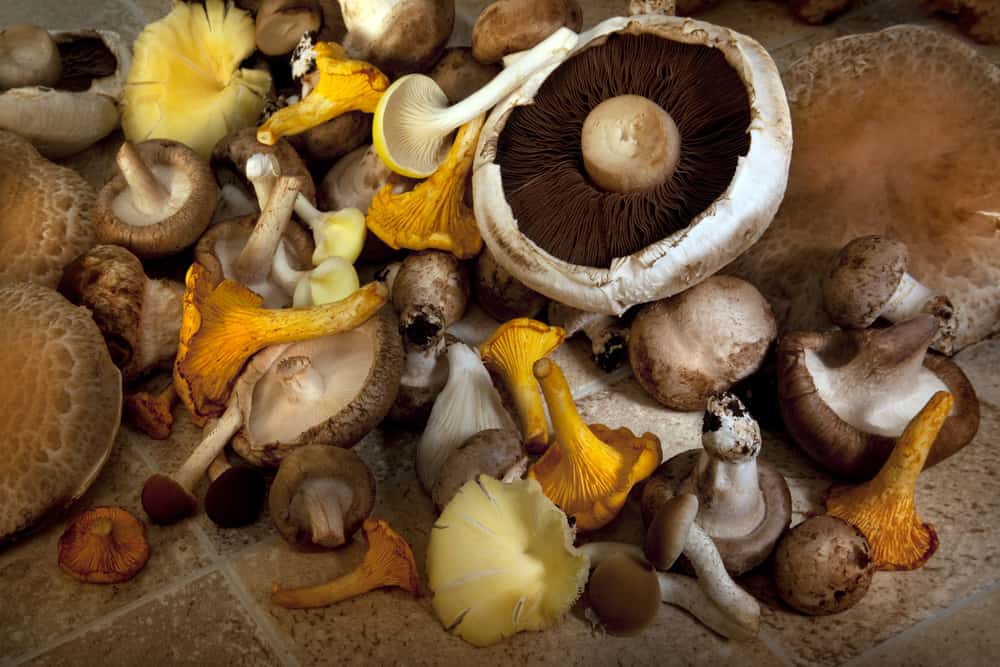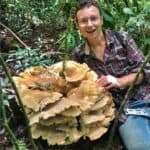Table of Contents
Growing mushrooms can be EASY. Don’t worry about fancy lab coats, pressure cookers, and the “need” for a sterile environment. The truth is, you don’t need any of this! All you need to follow some simple directions and you can have great success in cultivation.
Premanufactured Grow Kits = EASIEST way to grow mushrooms.
If you want to grow mushrooms in the EASIEST WAY POSSIBLE, you can buy premanufactured grow kits. Grow kits are vessels, like grow bags, filled with inoculated substrates. This means the mycelium is already within its preferred medium and all you need is fruit it!
Advantages of Using Premanufactured Grow Kits
- Less time, work, and effort than DIY grow kits.
- Ensures result no matter what!
- You can grow almost any species.
- Can be advantageous for large-scale producers.
- Less messy and work-intensive than making grow kits yourself.
- All you need to worry about is providing a proper fruiting environment.
Most Mushroom Growers Use Premanufactured Grow Kits
If you want to go for the premanufactured grow kits, don’t feel ashamed! Most mushroom growers in the USA use premanufactured grow kits. This is because it’s way easier for mushroom growers to focus on fruiting the mushrooms.
Top 5 Easiest Mushrooms to Grow From Spawn
If you don’t want to buy premanufactured grow kits, you can start earlier in the cultivation process. For amateur growers, this means using spawn to inoculate a substrate. Spawn is mushroom mycelium used for inoculation.
While spawn isn’t easy to make yourself, it is available and accessible. You can either find a local producer of spawn or buy it online! Spawn is usually grown on grain, but it can also be grown on “dowels” used for the inoculation of logs.
Note: You can start via spores, agar, or culturing a live mushroom, but this is more complicated. For amateur growers, it’s better to start with spawn.
1. The Classic Oyster Mushroom (Pleurotus ostreatus)
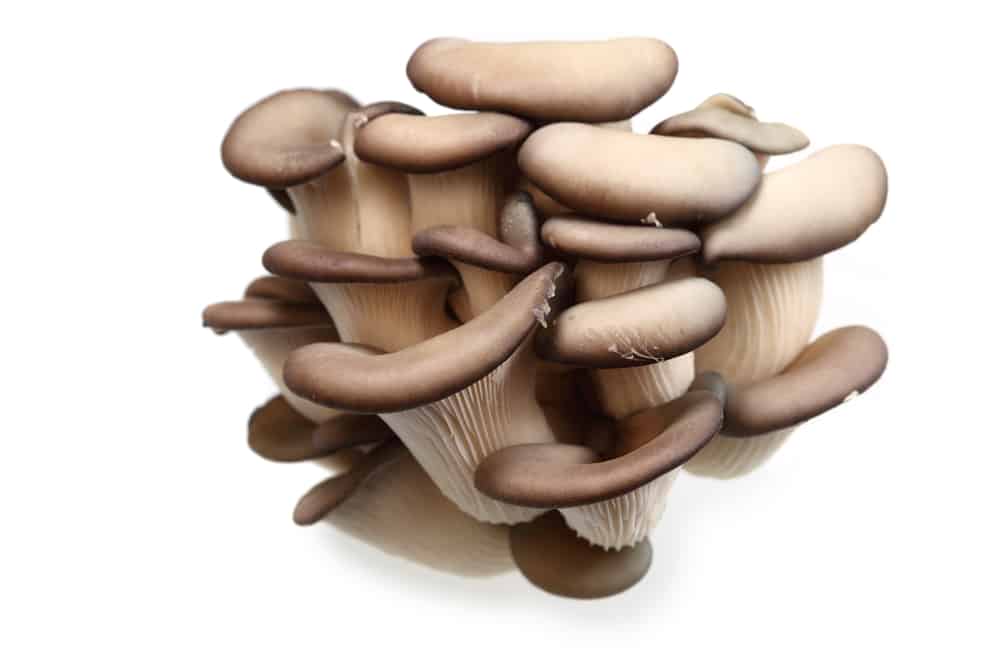
Oyster mushrooms are the most cultivated gourmet mushrooms. There’s a good reason for it. Oyster mycelium is vigorous and can eat almost anything! It fights contamination and handles a wide range of environmental conditions.
The most common oyster varieties include white oysters, gray oysters, and blue oysters. Pink and Yellow oysters are similar but different species.
Substrates Consumed By Oyster Mushrooms
- Sawdust
- Straw
- Coffee Grounds
- Wood Burning Pellets
- Agricultural Waste
- Any Woody Organic Materials
Unlike less vigorous mushrooms, oyster mushroom substrate only requires pasteurization. Pasteurization can be as easy as heating your substrate to 160F for one hour. Otherwise, other methods such as alkaline lime baths or cold-water pasteurization also exist.
2. Shiitake Mushrooms On Logs (Lentinula edodes)
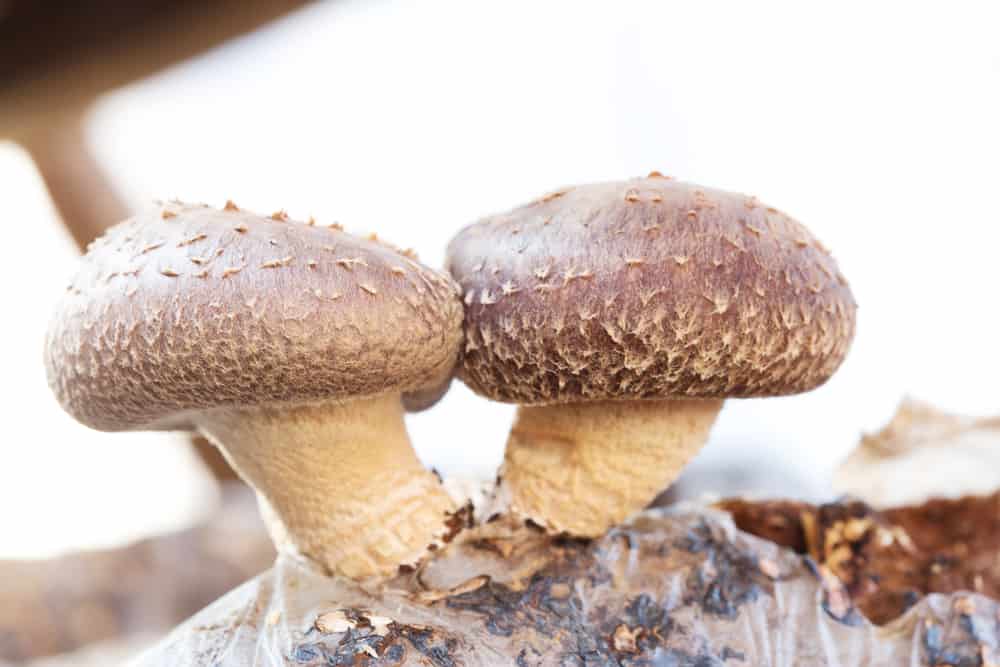
Shiitake cultivation on logs is the oldest known process for growing mushrooms. The Japanese mastered this technique over hundreds of years of practice. Unlike grow kits, Shiitake is traditionally cultivated on inoculated oak logs. While this is in many ways much easier than making grow kits, it is a much slower process.
How To Inoculate Logs With Shiitake
- Get Shiitake spawn plugs.
This is shiitake mycelium that is growing within hardwood dowels.
- Acquire hardwood logs.
While traditionally Shiitake is grown on Oak, other hardwood species work fine. This includes maple, alder, sycamore, apple, almond, and other fruit trees. You usually want hardwood logs around 6-10” in diameter and 2-3 ft long. If logs are fresh, let them sit 3-5 weeks before inoculation.
- Drill Holes In Your Logs
Spawn plugs are usually 5/16” so use a drill bit of equal size to make 1.25” deep holes in your logs. Make holes every 3-4” around the entirety of your log.
- Inoculate Your Logs
Just hammer the spawn plug into the holes!
- Paint Holes With Wax
After your plugs are in, cover them with a fine coat of melted wax. Use this by melting wax in a pot and using a paintbrush. This protects them from insects and other predators.
- Incubate and Fruit
Keep your logs in a dark and moist environment. After 5-6 months, dunk them in a bath of cold water for several hours or overnight. Remove the log and wait for the beautiful fruits to form!
Read our In-Depth Guide on how to grow Shiitake Mushrooms!
3. Wine Caps In Outdoor Beds (Stropharia rugosoannulata)
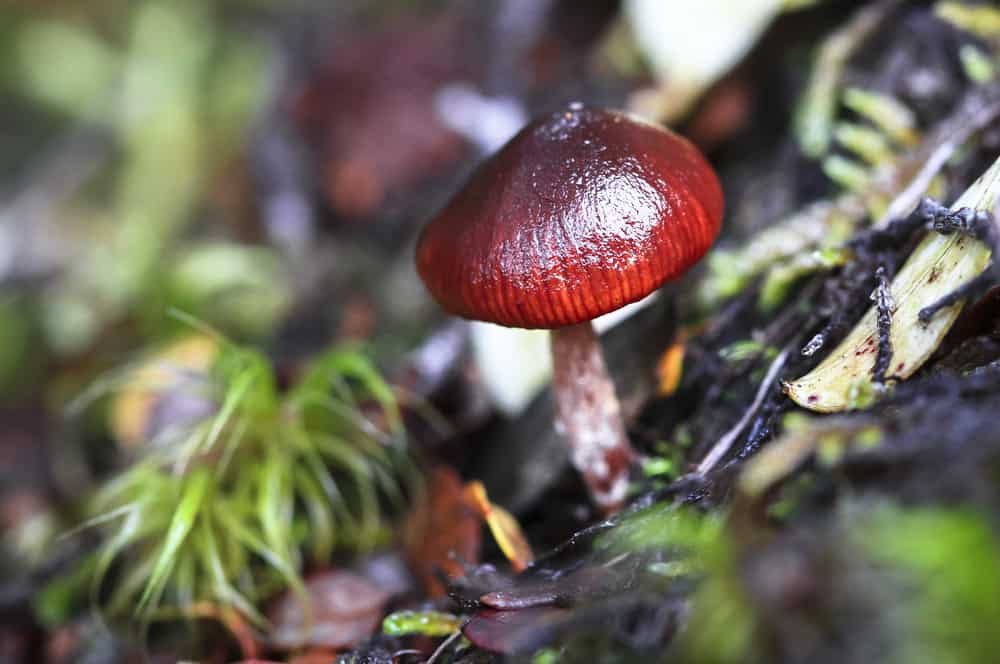
If you want to grow mushrooms in your garden, the Wine Cap Mushroom is what you’re looking for. This mushroom is so vigorous that it pretty much grows itself. All you need is to provide some wood chips, enough moisture, and voilà! You can have edible mushrooms growing in your garden.
Materials Needed:
- Wine Cap Mushroom Spawn
- Wood chips, Straw, and Other Carbon Rich Materials
- Garden space. It can be in your garden bed, between vegetable rows, or even your paths!
- Ability to keep your mushroom patch moist during dry seasons
Growing Wine Caps in your garden is easy. Most people recommend doing this in spring for a fall harvest, but this is flexible. The mycelium is hardy and will survive frosts under your blanket of mulch.
The process is simple. Lay down a layer of your organic matter, sprinkle some spawn, and add another layer of mulch! You want your layer to be approximately 4” (10 cm) deep.
Your ideal location will be shady and moist. Give your mushroom patch some irrigation during the dry season if necessary. You can add a new layer of mulch every fall to protect the mycelium and give it a new food source.
4. Pink Oysters (Pleurotus djamor)
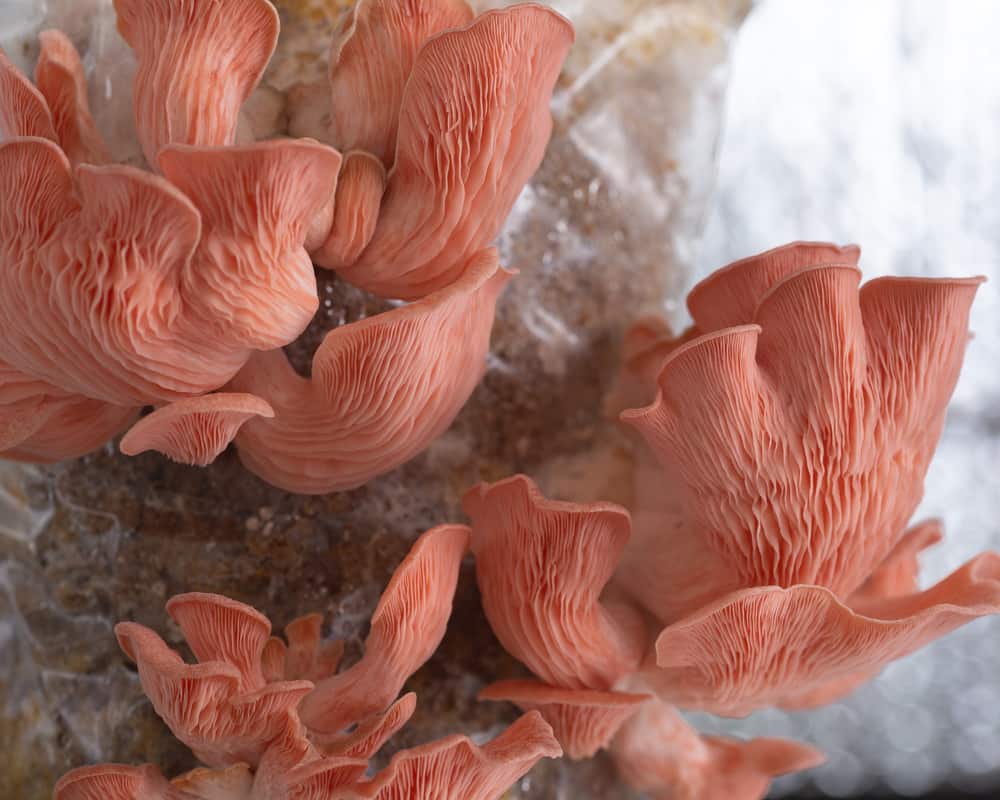
Pink Oysters are another hardy and easy-to-grow mushroom. It’s recommended for hot climates. This variety originates from the hot tropics and thus THRIVES in the heat. If you’re living anywhere with temperatures over 90 degrees, consider this one!
You will want to grow Pink Oysters like any other oyster mushroom:
- Get Pink Oyster grain spawn.
- Pasteurize your substrate. This can be straw, sawdust, or any agricultural waste.
- Inoculate your substrate with spawn. Do this within a closed vessel like a mushroom grow bag.
- Incubate for 2-3 weeks until your substrate is fully colonized.
- Fruit in conditions with 90%+ humidity.
The Easy Bucket Method
An easy way to upscale this cultivation method is to do it within 5-gallon buckets. Take a 5-gallon bucket and put ten 1/4” holes on the sides. Layer your pasteurized substrate and spawn in even layers. Keep it in a cool and dark environment for 2-3 weeks.
5. White Button Mushrooms (Agaricus bisporus)
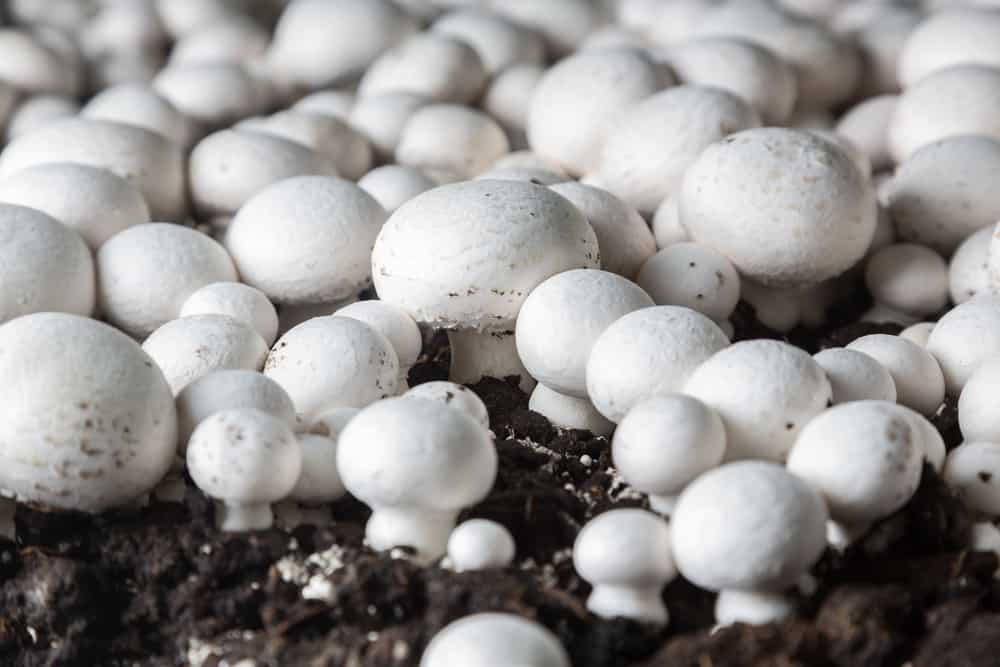
While these aren’t often cultivated at home, they can be easy to grow. In fact, the French have cultivated white button mushrooms for hundreds of years. Unlike oysters and other gourmet mushrooms, white button mushrooms are grown on compost.
Materials:
- Vessel -This can be a plastic bin or cardboard box. You can also attempt it in an outdoor setting or garden.
- Composted Manure – Fresh manure should be well composted. Otherwise, you can buy premade compost.
- White Button Mushroom Spawn – What you will use to inoculate.
- Vermiculite (optional) – This will help your mushrooms breathe.
Coco Coir (optional) – This will serve as a casing layer.
This process involves:
- Pasteurize your horse manure at 160F for 1-2 hours. Mix in 25% vermiculite if you have it handy.
- Once cool, place your composted horse manure in your bin/vessel. Mix about 5-15% white button mushroom spawn.
- Keep it somewhere cool and dark at around 70-75F for 2 weeks. Once you see mycelium colonizing throughout the substrate, you know it’s ready.
- Optionally, place a casing layer of hydrated and pasteurized Cococoir above your substrate.
- Keep in a humid environment and wait for the mushrooms to form! Spray with water if necessary!
